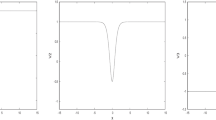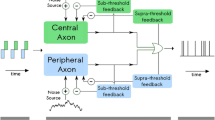Summary
A simulation study is reported of the spread of excitation in a digital computer model based quite realistically on a coelenterate nerve net. The question posed is whether an elementary nervous system with randomly distributed properties can discriminate between time patterns of stimuli at the same average frequency. Forty-four temporal patterns of stimulation, each composed of seven stimuli in the same total period of time were applied to each of nine simulated nerve nets with each of eleven different distributions of four rates of decay of facilitation. The results may be summarized as follows:
Aided by grants to Theodore H. Bullock from the National Institutes of Health. the National Science Foundation, and the Office of Naval Research. We gratefully acknowledge use of the Health Sciences Computing Facility and thank Steven Crocker for his assistance in rewriting portions of the nerve net program.
Predoctoral trainee under a program of the Brain Research Institute, supported by the National Institutes of Health. In addition, L. G. Fehmi was partially supported by an ONR contract on which Professor D. B. Lindsley is a principal investigator.
Access this chapter
Tax calculation will be finalised at checkout
Purchases are for personal use only
Preview
Unable to display preview. Download preview PDF.
Similar content being viewed by others
Literatur
Batswt, E. J., C. F. A. Pantin, and E. A. Robson: The nerve net of the sea anemone Metridium senile; the mesenteries and the column. Quart. J. micr. Sci. 101, 487 – 510 (1960).
Bullock, T. H.: The functional organization of the nervous system of Enteropneusta. Biol. Bull. 79, 91 – 113 (1940a);
The existence of unpolarized synapses. Anat. Rec. 78, Suppl. 67 (1940b) (Abstract);
Anatomical organization of the nervous system of Enteropneusta. Quart. J. micr. Sci. 86, 55 – 112 (1945);
Comparative aspects of superficial conduction systems in echinoids and asteroids. Amer. Zool. 5, 545 – 562 (1965);
Physiological bases of behavior. In " Ideas in modern biology" (J. A. Moose, ed.). Garden City, N.Y.: Natural History Press 1965.
Bul- Lock, T. H., and G. A. Horridge: Structure and function in the nervous systems of invertebrates. San Francisco: W. H. Freeman Co. 1965.
Hoasrdge, G. A.: The co-ordination of the protective retraction of coral polyps. Phil. Trans. B 240, 495 – 529 (1957).
Josephson, R. K.: Colonial responses of hydroid polyps. J. exp. Biol. 38, 559 – 578 (1961a);
Repetitive potentials following brief electric stimuli in a hydroid. J. exp. Biol. 38, 579 – 594 (1961b);
Spontaneous electrical activity in a hydroid polyp. Comp. Biochem. Physiol. 5, 45 – 58 (1961c).
Josephson, R. K., R. F. R.rss. and R. M. Worthy: A simulation study of a diffuse conducting system based on coelenterate nerve nets. J. theor. Biol. 1, 460 – 487 (1961).
Parker, G. H.: The elementary nervous system. Philadelphia: J. B. Lip-pincott Co. 1919.
Passaxo, L. M.: Primitive nervous systems. Proc. nat. Acad. Sci. Wash.)) 50, 306 – 313 (1963).
Segundo, J. P., G. P. Moore, L. J. Stensaas, and T. H. Bullock: Sensitivity of neurones in Aplysia to temporal pattern of arriving impulses. J. exp. Biol. 40. 643 – 667 (1963).
Segunno, J. P., D. H. Perkel, and G. P. Moore: Spike probability in neurones: influence of temporal structure in the train of synaptic events. Kybernetik 3 (2), 67 – 82 (1966).
Wiersma, C. A. C., and R. T. Adams: The influence of nerve impulse sequence on the contractions of different crustacean muscles. Physiol. comp. ('s-Gray.) 2, 20 – 33 (1950).
Author information
Authors and Affiliations
Rights and permissions
Copyright information
© 1993 Springer Science+Business Media New York
About this chapter
Cite this chapter
Fehmi, L.G., Bullock, T.H. (1993). Discrimination Among Temporal Patterns of Stimulation in a Computer Model of a Coelenterate Nerve Net. In: How do Brains Work?. Birkhäuser, Boston, MA. https://doi.org/10.1007/978-1-4684-9427-3_24
Download citation
DOI: https://doi.org/10.1007/978-1-4684-9427-3_24
Publisher Name: Birkhäuser, Boston, MA
Print ISBN: 978-1-4684-9429-7
Online ISBN: 978-1-4684-9427-3
eBook Packages: Springer Book Archive




